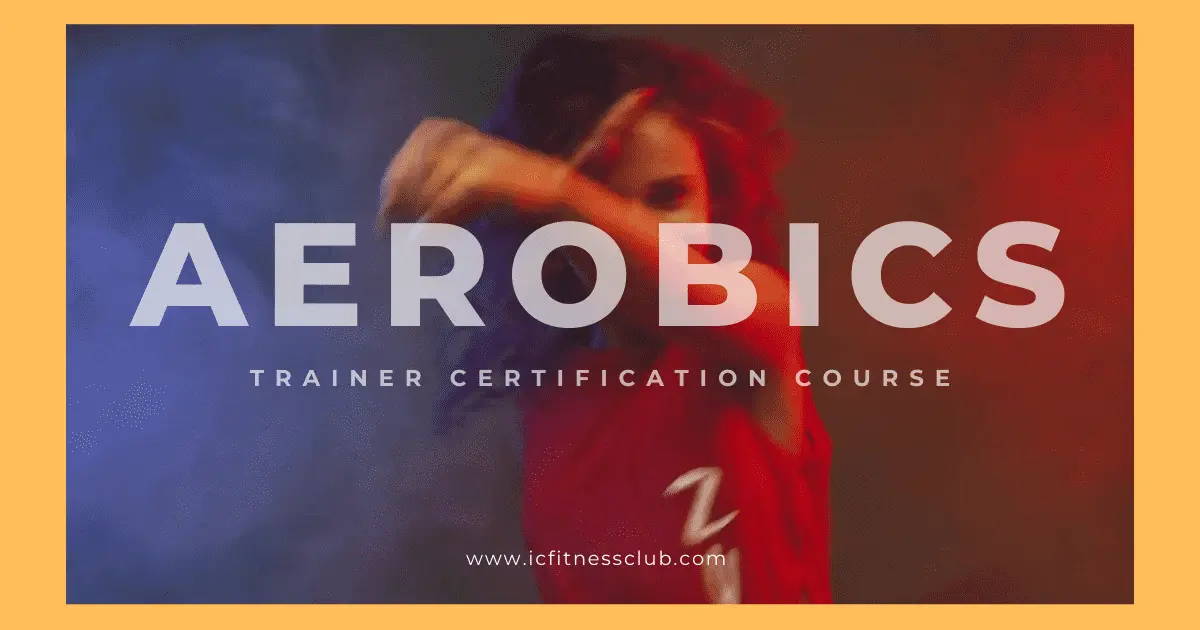Aerobics Trainer Certification Course – IC Fitness Club
An aerobics trainer certification course in Delhi is a program designed to provide individuals with the knowledge and skills needed to lead safe and effective aerobic exercise classes. These courses typically cover topics such as anatomy and physiology, exercise science, teaching methods, program design, and safety considerations.
Aerobic exercise, also known as cardio exercise, is a form of physical activity that involves rhythmic movements that increase the heart rate and breathing rate. Examples of aerobic exercises include running, cycling, dancing, and swimming. Aerobic exercise classes are popular in fitness centers and gyms, and an aerobic certification course can help fitness professionals to become qualified to lead these classes.
Responsibility of an Aerobics Trainer
The responsibilities of an aerobics instructor can vary depending on the setting in which they work, but typically include:
- Planning and Leading Classes: An aerobic exercise instructor is responsible for planning and leading safe and effective classes that meet the needs of their participants. This includes choosing appropriate music, selecting exercises that are challenging but achievable, and providing modifications for participants with injuries or limitations.
- Demonstrating Exercises: The instructor should be able to demonstrate proper form and technique for all exercises they are teaching, and provide corrections and feedback to participants to ensure they are performing the exercises correctly.
- Ensuring Safety: The instructor must prioritize the safety of their participants, including monitoring the room for hazards, providing appropriate warm-ups and cool-downs, and making sure that participants are not pushing themselves beyond their limits.
- Providing Motivation and Encouragement: An aerobics instructor should create a positive and encouraging environment, and provide motivation and support to participants throughout the class.
- Continuing Education: To maintain their certification and stay up-to-date with the latest research and trends in fitness, the instructor should engage in ongoing education and training opportunities.
Overall, the responsibility of an aerobic exercise instructor is to create a safe and supportive environment that encourages participants to achieve their fitness goals while having fun and enjoying the class.
Eligibility Criteria
The eligibility requirements to become an aerobics trainer can vary depending on the organization offering the certification. However, some common eligibility requirements may include:
- Minimum Age: Most organizations require trainers to be at least 18 years old.
- Educational Background: IC requires a high school diploma or equivalent qualification.
- CPR/AED Certification: IC requires First aid and CPR certificate and conducts First aid and CPR Programs for the trainers who do not have the certificate.
- Experience: There is no Experience Required.
- Fitness Level: Trainers should have a good level of fitness to demonstrate exercises and lead classes.
- Certification Exam: To become certified, trainers must pass IC’s exam that covers topics such as anatomy, exercise science, program design, and teaching methods.
Scope for the Aerobics Trainer
The scope for an aerobics trainer can be quite broad, as there is a high demand for fitness professionals who can lead safe and effective exercise classes. Some potential career paths for an aerobic exercise trainer include:
- Group Fitness Instructor: Aerobics trainers can become certified to teach a variety of group fitness classes, such as cardio kickboxing, Zumba, or indoor cycling.
- Personal Trainer: Some aerobic exercise trainers may choose to become certified as personal trainers, providing one-on-one coaching and training to clients.
- Health and Wellness Coach: Aerobics trainers may also pursue additional certifications in health coaching or wellness coaching, allowing them to provide a more holistic approach to fitness and health.
- Corporate Wellness: Some companies offer wellness programs to their employees, and aerobic exercise trainers can be hired to lead group exercise classes or provide wellness coaching.
- Entrepreneurship: Aerobic exercise trainers can also start their own fitness businesses, such as creating their own fitness classes, and coaching programs, or even opening their own fitness studios.
Overall, the scope for an aerobic exercise trainer is quite diverse, and the demand for qualified fitness professionals is expected to continue to grow in the coming years. With the proper training and certification, an aerobic exercise trainer can build a successful career in the fitness industry.
Syllabus of Aerobic Instructor Course – IC Fitness Club
The following topics are commonly covered in such courses:
- Anatomy and Physiology: An understanding of the human body and how it responds to exercise is essential for a successful aerobics instructor. This includes knowledge of the muscular, skeletal, and cardiovascular systems.
- Aerobic Exercise Principles: The principles of aerobic exercise, including the components of fitness, principles of training, and the importance of warming up and cooling down.
- Choreography and Music: Aerobics involves movement to music, and as such, a course will cover topics such as counting music, creating choreography, and selecting appropriate music.
- Safety and Injury Prevention: The instructor must be able to identify and address safety concerns and prevent injuries in class. This includes proper form and technique, avoiding overexertion, and dealing with emergencies.
- Teaching Skills: The instructor must be able to communicate effectively with participants, provide feedback and encouragement, and create a positive and motivating atmosphere.
- Class Design and Planning: Planning and designing a well-rounded aerobics class is essential for achieving desired fitness goals. This includes selecting appropriate exercises and creating a variety of workouts that target different muscle groups and intensity levels.
- Special Populations: Understanding the needs and limitations of special populations such as older adults, pregnant women, and individuals with medical conditions is crucial for providing safe and effective instruction.
- Business Management: Running a successful aerobics class requires knowledge of business management, including marketing, budgeting, and client retention.
- Certification and Continuing Education: A course may provide guidance on obtaining certification and continuing education opportunities to stay up to date with the latest research, techniques, and trends in the field.
Course Details
- Course Duration: 6 Months / 24 Weeks
- Course Fees: INR 17,500 ❌ ❌
- Offer Price: INR 10,000/- ✅ ✅ (Limited Time Period Offer)
- What’s Included in the Fees:
- Comprehensive Study Material
- Enrollment Fees
- Examination Fees
- Full Course Fees (No hidden charges)
Mode of Classes
There are two modes of classes
- Online
- Offline



